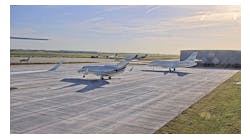With airports throughout the world undergoing massive improvement programs to respond to increasing security threats and record levels of passengers, architects are seizing the opportunity to implement sustainable design strategies into a building type that has received little scrutiny for its energy performance in the past.
Throughout the country the green movement has taken to the skies as more and more major airports have been installing sustainable technologies in order to make some of the world's largest transportation hubs more environmentally friendly.
These green airport construction projects will help lead the aviation industry into a cleaner future.
Denver International Airport
Working together with Constellation Energy, the Denver International Airport has just completed a brand new 4.4 megawatt solar installation that adds to an already impressive foundation in place. This project marks the third major ground-mounted solar installation at DIA.
"With the addition of this solar facility, Denver International Airport's three solar array systems now produce approximately six percent of the airport's total power requirements," said Kim Day, aviation manager for DIA.
"We support alternative energy applications at DIA because these projects are good for the environment while positively impacting our bottom line; they are financially sustainable. This airport was built with a goal of being green, and with this additional solar array, Denver International Airport now has one of the largest solar installations in North America."
The mounted installation will use about 19,000 Yingli Solar photovoltaic panels to generate about 7,000 megawatt-hours of electricity annually. Generating that much energy using conventional methods would have required releasing more than 5,000 metric tons of carbon dioxide into the atmosphere, according to the US Environmental Protection Agency.
This latest addition is the third large-scale solar installation at the Denver International Airport. Together the three installations will be able to generate a total of more than 8 megawatts, the largest single solar generation at any commercial airport in the United States.
Constellation Energy will continue to own and maintain the solar installation, and DIA will purchase the system's electricity over the next two decades. The company has grown to be a major player in the US solar industry, with 95 megawatts worth of solar installations throughout the United States.
By structuring its solar projects as power purchase agreements, Constellation Energy requires no upfront capital from its customers and is able to provide power at a fixed cost that is less than projected market rates.
Oakland International Airport
In the Spring of 2004 the Oakland International Airport broke ground on a $300 million Terminal Improvement Program, the largest single aviation project in its 78-year history. The plan is comprised of the Terminal 2 Improvement Project, which included the construction of a new green concourse with five additional gates plus a food court, retail shopping area, and new ticketing, security and baggage claim areas.
Restroom Partitions(made from recycled and other rapidly renewable materials);Ceiling Tiles(made from recycled materials that have the ability to reflect light, resulting in decreased use of heating and air conditioning systems);Wall Wainscot(made from recycled materials); andRestroom Floors(made of terrazzo, a long lasting, durable polished concrete or epoxy material)Boston's Logan International Airport
The US Green Building Council's (USGBC)LEED certification program formerly did not incorporate airports, but a new level of certification has been slowly in the works for years. That goal took a giant leap forward when the brand new Terminal A built at Boston's Logan International Airport was the first in the world to achieve LEED certification
"We had LEED certification as a charter from the beginning, and we all agreed to it," says Kent Turner, the project manager for the HOK on the new terminal. "We incorporated such green strategies as energy-efficient HVAC equipment, construction waste and demolition recycling, and the use of recycled materials. One of the challenges was integrating day-lighting into the terminal, since expanses of glazing next to aircraft requires deluge sprinklers and costs more than a conventional blank wall."





